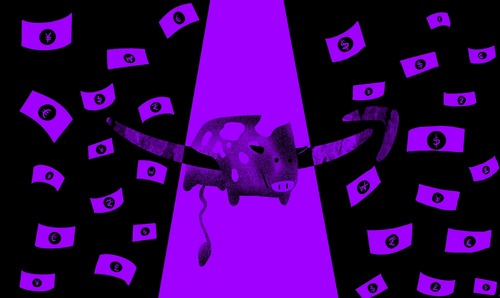The word "disrupted" gets thrown around a lot when talking about startups — more often with comical optimism than real substance.
But, if there is one company that has truly disrupted a market, it's Netflix.
From selling DVDs online to pioneering this weirdly esoteric, new-age concept of streaming, Netflix has surely "disrupted" the entertainment industry.
And, over a 24-year long run, they have reaped the benefits of their innovations. But, alas, good times always see an end.
Over the past year, Netflix's share price has dropped by a crazy 68%. And, since 2009, for the first time, they reported a 200K decrease in their subscriber numbers. The predicted user trends also don't look very good.
In short, Netflix's boat is sinking. And, it's high time Netflix looks for life-support.
In Netflix's case, that life-support is advertisements. So, here's how ads can SAVE Netflix!
But first, tell me more about Netflix. How did they disrupt the entertainment industry?
It all started when Reed Hastings, Netflix Founder & CEO, was six weeks late to return his "Apollo 13" VHS cassette. He was charged a hefty $40 fee. But, from an awful experience came a brilliant idea.
At that time, the video rental services sector was a $16B industry. And, given that these rental shops would act like tough librarians, there was a huge place for improvement.
Hastings along with Marc Randolph decided to start Netflix in 1997 as an online DVD rental service. Their advantage was simple — people could order any DVD online to directly reach their doorsteps. So, they no longer have to worry about the limited choices in the local shop.
But, they didn't stop there. In early 2000, Netflix introduced its famous monthly subscription model and dropped the due dates, and late fees structure. Now, users could simply pay a flat subscription fee to receive DVDs of their choice.
Since then, it has very religiously stuck to its subscription model. That's even after its pivot to becoming a streaming platform in 2007.
The new model, introduced a combination of licensed television, plus original content on the streaming platform.
And, fortunately, unlike Apollo 13, Netflix successfully pulled off its very own moon landing, ie. acquiring 222M paying subscribers to date!
The phenomenal rise of Netflix ... and then the fall
Since its launch back in 2007, Netflix has enjoyed a steady increase in both subscribers and revenue. But, it was during the pandemic when they saw exponential growth!
While you and I were busy binging Money Heist and Squid Game, Netflix was minting cash! In 2021, Netflix made ~$30B in revenue while its net income increased by 85% to $5.12B. Additionally, in the last quarter of 2021, it also added 8.3M paying users.
But, the pandemic spurt came crashing as 2022 drove in. In the first quarter of 2022, Netflix lost a record 200K subscribers. This was totally unexpected as Netflix had never reported negative growth since 2009!
Consequently, its Q1 2022 revenue also fell to $7.87B from a forecasted $7.93B. That's still an increase of $1.58B from the previous quarter.
But, the trend is still concerning. Netflix is not growing as quickly as it used to and that is hinting at very grim times in the future.
In fact, it is expected to lose 2M more subscribers in the next quarter!
So, what are the roadblocks to Netflix's endless growth?
Well, there is no one thing that's behind this slowdown. But, in fact, it's a combination of various factors.
1) Operations Shutdown in Russia — The 200K fall in the first quarter is simple math. Netflix gained 500K subscribers in Q1, a downgrade from the predicted 2.5M. But, since it suspended its services in Russia due to the ongoing war, it also lost 700K subscribers. So, net-net, it lost 200K subs.
2) Password Sharing — One of Netflix's huge concerns is the volume of password sharing on the platform. Its 222M subscribers supposedly share their passwords with 100M more users. If we consider the average monthly revenue per streaming customer to be $11.67, then Netflix is losing ~$1.1B each month!
3) Market Saturation in North America — The US and Canada market accounts for the majority of Netflix's growth over the years. But, now it seems like Netflix has reached market saturation in these countries. It has over 75M members here, which accounts for 60% of the total households.
4) The India Bet — Now that Netflix has reached market saturation in North America, the only way to keep growing is by targeting large markets like India. But, unfortunately, Netflix's India bets haven't paid off as expected. Majorly, the poor performance can be attributed to 2 reasons:
- Netflix's high prices and,
- the dominance of Disney+ Hotstar & Amazon Prime which collectively account for 41% of the streaming market in India
5) Heavy competition — Finally, while Netflix started as a lone warrior in the streaming space, the field has become increasingly crowded over the years.
New players are eating Netflix's lunch...
If we consider the points from the previous section, we can gather a couple of things:
- Market saturation is a HUGE problem for all streaming platforms
- All competitors are essentially fighting for a limited pool of users.
From the user's perspective, the evolution of the entertainment space has not been all positive.
Of course, the convenience of streaming original television on the go is incredible. But, unlike before, when a user would spend ~INR 300 on cable, now they have to buy subscriptions to multiple platforms. That is essentially a 3x increase in their expenses.
Now, naturally, Netflix's relatively high prices don't help in this situation. So, other streaming platforms are bound to eat Netflix's market share.
For instance, while Netflix lost subscribers in Q1 2022, Disney Plus gained 11.8M, new subscribers, during the same time. Similarly, HBO Max also gained an additional 3M subscribers, while Roku gained 1.1M new users.
... but, ads can save the day for Netflix!
So, it appears that Netflix is basically trapped from all corners. And, now any more price hikes could work against its goal of meeting its profit margins.
Fortunately, there's one way Netflix can monetize all of its current non-paying users.
Take the example of Roku, Disney & Amazon Prime. All of these platforms have more affordable plans, with the minor inconvenience of ads.
In fact, with the ad-supported model, Roku was able to increase its revenue 4 times as quickly as Netflix did over the past few years.
But, what will the impact of adding ads look like for Netflix in terms of numbers?
Well, we know that ~100M users are accessing Netflix using someone else's account. Now, if it introduces a low cost, ads-supported plan
- say, 100M non-users subscribe
- giving $40/user of ad revenue (Roku’s proxy)
we get, 100M * $40 ⇒ $4B additional revenue.
This could possibly also discourage password sharing. And, with better data support for advertisers, Netflix's ad network could be the life support it desperately needs!
Netflix is definitely on board with this solution. As it internally announced that Netflix ads might debut on the platform by the end of 2022!








